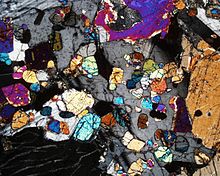Poikilitic structure
A mineral compound in which smaller crystals are surrounded by larger ones is called a poikilitic structure . It can best be observed in thin sections .
etymology
Poikilitisch derives from ancient Greek ποιχίλος - poikilos with the meaning colorful, colored, artful, variable, diverse, changing in allusion to the colorful, piebald effect of the mineral inclusions in the host crystal.
Definition and description
The term poikilitic is used for magmatic structures , the term poikiloblastic is used for metamorphic rocks (from blast : newly grown crystal , derived from ancient Greek βλαστησις - blástesis - germination, drifting, growing ).
The condition for the use of the term poikilitisch is the inclusion ratio of several small crystals in a larger host crystal ( English oikocryst ) that arises during the magmatic cooling process . The inclusions (English chadacrysts ) can consist of one or more types of mineral. The timing of the inclusion ratio is not taken into account (the larger host crystals can grow before, during or after the inclusions crystallize; the end result is decisive). It is important that the host crystals have fewer nuclei than those of the inclusions. The inclusions can be statistically distributed or they can be regulated in the host crystal. Due to the presence of many foreign crystals, the host crystal sometimes appears to be perforated. This is called a sieve structure.
Micropoikilitic structures occur in spherulite , for example , in which quartz crystals enclose tiny feldspar fibers. This structure is known as the snowflake microstructure . It is assumed that in this case the germination rate of quartz is increased compared to the feldspars.
A special case of the poikilitic structure is the ophitic structure , also called dolerite structure , which mainly consists of unregulated, strip or plate-shaped plagioclases , which are surrounded by other minerals, mostly very large pyroxene ( augite ). The plagioclase forms significantly more germs than the host crystal. Ophitic structures can show transitions to subophitic and intergranular structures .
In the poikiloblastic structures , the various mineral grains do not germinate from a melt, but rather mature in a solidified structure. The mineral type with preferred growth in size becomes the host crystal, which encloses the more slowly growing mineral types. A special case of poikiloblastic structures are helicoid textures , in which the inclusions have very specific spatial orientations.
In contrast to the porphyry structure , the host crystals of the poikilitic structure usually do not show any clear crystal faces. Poikilitic structures can be explained as a pure crystallization phenomenon and are neither related to demixing phenomena nor recrystallization .
Occurrence
Poikilitic structures can be found in a wide variety of magmatites. In phaneritic, ultramafic rocks , for example, host crystals of pyroxene or amphibole , several centimeters in size, can enclose olivines , chromites and other minerals in the millimeter range. In some granitoids , host crystals are surrounded by alkali feldspar , which crystallized in the vicinity of the solidus , minerals that were formed in the higher temperature area. With basaltic rocks , ophitic to subophitic structures are the rule.
To conclude, some examples of political structures should be given:
- Peridotites of the Stillwater Complex in Montana - Olivine in Pyroxene
- Websterite from the Stillwater Complex, Montana - Orthopyroxene in clinopyroxene
- Norite of the Bushveld Complex in South Africa - plagioclase in orthopyroxene and plagioclase and orthopyroxene in augite
- Peridotite from Qarsut in western Greenland - Olivine in Augit
- Gabbro from north Skye - plagioclase and olivine in Augit
- Olivine gabbro from the Middle Border Group of Skaergaard-Intrusion , East Greenland - Olivine in Plagioclase and Olivine in Augit
- Feldspar-bearing peridotite from Rhum , Scotland - olivine in plagioclase
- Peridotite of the Shiant Isles , Scotland - olivine in plagioclase
- Diabase storage corridor of the Palisades Sill in New York State - olivine in pyroxene
- Madupit of the Leucite Hills in Wyoming - ophitic diopside in phlogopite
- Impaktschmelzen 65357 and 65358 of the Apollo 16 mission - plagioclase, olivine and augite in calcium -poor pyroxene
- Moon meteorite Oued Awlitis 001 from Morocco / Western Sahara , a feldspar-rich impact melt - olivine, pigeonite and augite in plagioclase
literature
- Hans Murawski: Geological Dictionary . Ferdinand Enke Verlag, Stuttgart 1992, ISBN 3-432-84109-4 .
- Wolfhard Wimmenauer: Petrography of igneous and metamorphic rocks . Ferdinand Enke Verlag, Stuttgart 1985, ISBN 3-432-94671-6 .
- Myron G. Best, Eric H. Christiansen: Igneous Petrology . Blackwell Science, Inc., Malden, Mass. 2001, ISBN 0-86542-541-8 .
Individual evidence
- ↑ Lofgren, GE: Spherulitic textures in glassy and crystalline rocks . In: Journal of Geophysical Research . tape 76 , 1971, p. 5635-5648 .
- ^ Wager, LR: A note on the origin of ophitic texture in the chilled olivine gabbro of the Skaergaard intrusion . In: Geological Magazine . tape 98 , 1961, pp. 353-366 .
- ^ Mitchell, AA: Magma replenishment, and the significance of poikilitic textures, in the Lower Main Zone of the western Bushveld Complex, South Africa . In: Mineralogical Magazine . tape 62 , no. 4 , 1998, pp. 435-450 .
- ↑ MacKenzie, WS et al. a .: Atlas of igneous rocks and their textures . Longman Group Limited, Harlow, Essex 1982, ISBN 0-582-30082-7 .
- ^ Meyer, C .: Lunar Sample Compendium: 65357/65358 . 2012.
- ↑ Wittmann, A. u. a .: Petrogenesis of poikilitic lunar impact melt meteorite Oued Awlitis 001 . In: 46th Lunar and Planetary Science Conference . 2015.
